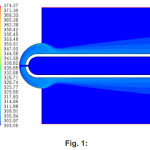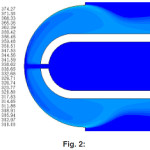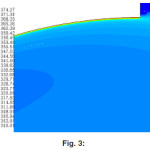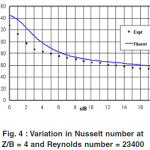R.E. Shelke¹* and L.B. Bhuyar²
¹Government I.T.I. Morshi Road, Amravati - 444 603 (India).
²Department of Mechanical Engineering, PRM Institute of Technology and Research, Badnera Amravati - 444 701 (India).
Article Publishing History
Article Received on :
Article Accepted on :
Article Published :
Article Metrics
ABSTRACT:
2 dimensional CFD simulation of slot jet impingement cooling on concave surface is reported using Ansys FLUENT Post software at specified geometry and boundary conditions. Realizable k-ª model has been used for resolving the turbulence.It has been observed that the results obtained from CFD model are in good agreement with that of the experimental results.
KEYWORDS:
Heat Transfer; Computational Fluid Dynamics (CFD); Contours
Copy the following to cite this article:
Shelke R. E, Bhuyar L. B. CFD Analysis of Slot Jet Impingement Cooling on Concave Surface. Orient. J. Comp. Sci. and Technol;2(2)
|
Copy the following to cite this URL:
Shelke R. E, Bhuyar L. B. CFD Analysis of Slot Jet Impingement Cooling on Concave Surface. Orient. J. Comp. Sci. and Technol;2(2). Available from: http://www.computerscijournal.org/?p=2150
|
Introduction
CFD has now become an integral part of the engineering design and analysis2-3. Engineers can make use of the CFD tools to simulate fluid flow and heat transfer phenomena in a design and predict the system performance before manufacturing. The advantages of CFD are numerous, namely, fewer iterations to the final design, shorter time to launch the product, fewer expensive prototypes and so on.
Furthermore, CFD provides a cost-efficient means of testing new designs and concepts that would otherwise be too expensive & hazardous to investigate.
CFD analysis
2 dimensional CFD simulation of slot jet impingement cooling on concave surface is performed using Ansys FLUENT Post software. Geometry and boundary conditions are obtained from.1
Details on Boundary Conditions Inlet
Inlet velocity = 3.48933 m/s Temperature = 300K Turbulent intensity = 10% Hydraulic diameter = 0.06 m
Heated wall
Heat Flux = 10000W/m2
Wall and nozzle walls
Adiabatic
Outlet
Pressure-outlet
Solver setting
Pressure-velocity coupling = SIMPLE
Discretization
Pressure → Standard
Momentum → Second Order Upwind
Turbulence Kinetic Energy → Second Order Upwind Turbulence dissipation rate → Second Order Upwind Energy → Second Order Upwind
Under relaxation factors
Pressure → 0.5
Density → 1
Body Forces → 1
Momentum → 0.5
Turbulence Kinetic Energy → 0.6
Turbulence dissipation rate → 0.6
Turbulence Viscosity → 1
Energy → 1
Results and Discussion
Temperature contours (K)
These are shown in the figure 1, 2 & 3. It has been observed that The maximum temperature exist in the zone which is far away from the stagnation point.
Nusselt Number Profile Comparison
2 dimensional CFD simulation of slot jet impingement cooling on the concave surface is reported using Ansys FLUENT Post software at the required and specified boundary conditions. The Nusselt number profile comparision at Z/B = 4 and Reynolds number of 23400 is as shown in the figure 4. It is observed from the figure 4 that the Nusselt number in CFD analysis is in good agreement compared with the experimental results.
Conclusions
The results obtained from the CFD analysis and experimental results are quite close to each other.It clearly indicates that model developed in CFD analysis is in good agreement with experimental values thereby,validating the procedure for formulation of model using CFD . This procedure can be adopted with confidence for predicting the values for any kind of surface.
References
1. Yang G., Choi M., Lee J. S., “An Experimental Study of Slot Jet Impingement Cooling on Concave Surface: Effect of Nozzle Configuration and Curvature”, International Journal of Heat and Mass Transfer, 42: 2199-2209 (1999).
2 www.google.com, www.cfdreview.com
3 Ghoshdastidar P.S., “Computer Simulation of Flow and Heat Transfer.” Tata McGraw- Hill, (1999)
4 Shelke R.E.,Bhuyar L.B.,” Study and Model Formulation for Curved Surface using Computational Fluid Dynamics” Oriental Journal of Computer Science and Technology, 2(1): 75-79 (2009).

This work is licensed under a Creative Commons Attribution 4.0 International License.




